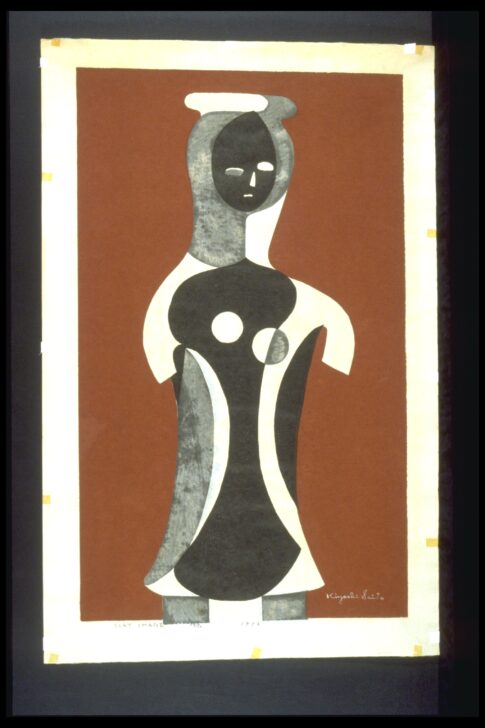Clay Image (D) (Haniwa figure of a standing shamaness)
Saitō Kiyoshi

Description
Subject Matter:
Copied from (1958/2.25)
Though initially simple clay cylinders, in the fourth century haniwa began to be shaped as warriors, female shrine attendants, everyday objects, and animals. In Saitô’s presentation these traditional figures are pared down to their essential shapes, their basic geometric components emphasized with blocks of patterns and colors reminiscent of Cubism. Dusted with malachite, Saitô’s prints of haniwa glitter in the light, evoking the dynamism of these occasionally playful clay sculptures.
Saitô Kiyoshi (1907–1997) was a member of the Creative Print (sôsaku hanga) movement, a group of artists dedicated to bringing individualism, experimentation, and autonomy to Japan’s centuries old ukiyo-e tradition. One of the most well-known forms of Japanese art, ukiyo-e is a type of woodblock print that first appeared in the mid- to late Edo period (1615–1868). Cheap to produce, widely available, and very popular in the late eighteenth century, by the early twentieth century when Saitô was working demand for woodblock prints in Japan was waning. Historically the production of ukiyo-e was dominated by giant publisher-controlled studios where the labor was divided and no single artist was responsible for creating an entire work. The Creative Print movement aimed to topple these traditions by bringing control of the woodblock print process into the hands of the individual artist.
In the past even famous ukiyo-e artists like Katsushika Hokusai (1760–1849) were responsible only for the initial steps of the process. The artist would draw a design that would be handed off to the carver, who cut around the lines, creating a separate block for each color of the print. Finally, the printer placed paper on top of an inked block and rubbed it with a special pad made of bamboo fibers. Creative Print artists performed each of these steps themselves, seeing a print through from start to finish. This essential difference emphasized the artist as a talented individual and distanced the modern woodblock print from what was seen by many Japanese as its plebian origins. Saitô was a distinguished printmaker, whose success in the international art world helped bring the Creative Print movement to prominence and raised the status of the modern print in Japan.
Physical Description:
This print depicts a single figure, a Haniwa clay figure, in the center. The background is a rusty red and the figure is depicted in color blocking and soft geometric shapes. There is a signature in the bottom right corner.
Usage Rights:
If you are interested in using an image for a publication, please visit https://umma.umich.edu/request-image/ for more information and to fill out the online Image Rights and Reproductions Request Form.